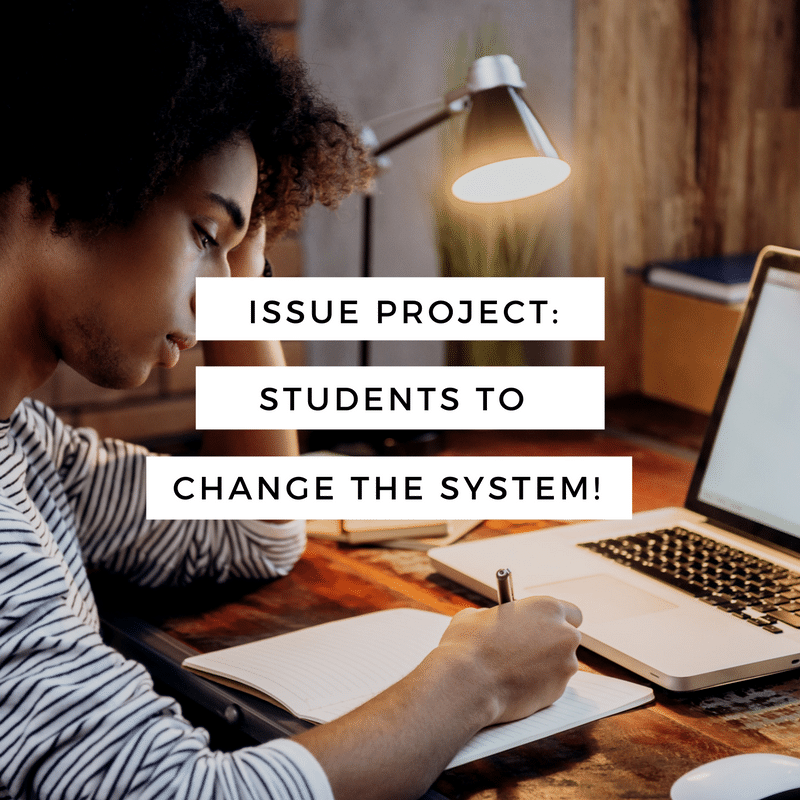I teach high school government because I want my students to become empowered, active citizens who know how to effect the change they want to see. And the best way to get them there is to have them effect change while they are still students in my classroom. Enter the Issue Project.
First, each student identifies a social, political, or economic problem about which they care deeply. Each week, students get classroom time to work on guided activities that connect their issue to the content covered that week, and structure their research so they can critically assess whether a certain strategy is useful for their issue or not. As the weeks progress, the structure gets loosened, and students are able to guide their own project in a way that is meaningful and relevant for them. This culminates in students sharing out their ideas with the class, and a portfolio consisting of a problem statement (what is their issue, and how does it impact others?), their solution to that problem, and a well-thought-out plan for implementing the solution.
Issue Project Day tends to be Thursday or Friday of each week. I either secure Chromebooks or a computer lab so students can work independently on their projects. They have specific tasks and goals that must be met by the following Monday, during which I come around and check their work (just a cursory look at this point; just to make sure they are on track). The earlier tasks take the form of worksheets completed with the aid of the Internet – but as the project goes on, students increasingly write more, which will develop into the contents for their portfolio by the project’s end.
[bctt tweet=”Students are encouraged to focus on whatever issue they personally care about.” username=”EducatorsRoom”]
I do not shy away from controversial topics for Issue Project. Students are encouraged to focus on whatever issue they personally care about – and a lot of times, that ends up being abortion, legalizing marijuana, same-sex marriage, or something else just as touchy. Now this makes sense: controversial stuff is controversial for a reason, and so my students often have strong opinions on these issues. But this requires a safe classroom community where students can comfortably disagree with one another, and support each other toward the larger end of empowerment, whatever its form. I wait a couple of weeks to introduce the project so that this classroom community is already established. I also ensure that students keep the focus on why we are doing this project: what are they learning about how our system is set up, and how can they use that system to create the world in which they want to live?
[bctt tweet=”These projects builds in student autonomy.” username=”EducatorsRoom”]
I love this project, for a few reasons. First, it builds in student autonomy. When students have a chance to choose, then the work becomes a lot more meaningful for them. Still, that choice is harnessed with content-specific purpose, while not losing sight of my purpose to empower. Second, it requires creativity, divergent thinking, and critical thinking. While some students select the same issue, no one’s solution and implementation plan should be the same; there is no correct answer. This not only reflects real-world experience but also teaches that social movements can experience success through a variety of mechanisms. Third, the project has an authentic purpose. Students experience their issue in the world outside of the classroom, and they learn valuable tools for navigating and changing that very world.
While this is my inaugural term implementing this project, I am already seeing increased student engagement with the content we are learning. Some students are really passionate about their issue and are producing really thought-out, high-effort work. I see students bringing in skills and passions from other classes, which help them build interdisciplinary relationships across their education. There are some really cool topics being covered in my class, such as raising the minimum wage, environmental practices such as fracking, college funding for undocumented immigrants, and unequal treatment of women in the workplace. In course of seeing my students’ identified issue, I learn more about my students, which then of course builds a stronger rapport and safer classroom environment.
However, in the course of implementing this project , I am facing two major challenges. First, some students consistently do not have their prompts ready for checking on Monday. I worry that they will not have the entire project done by the end of the term if they do not keep up with each week’s prompts.
Second, I wish to integrate an even stronger implementation component. The project is very computer-research-based; and while students get the opportunity to really think about their issue and how to bring about change, I want to encourage more of them to actually MAKE that change. I’m hoping the project will inspire them to then put their plan in to action, but need to figure out a way to integrate that action piece more meaningfully into the project. So far that is taking the form of guest speakers, but I feel like there’s more there to flesh out in future years with this project!
I am sure these issues will work out as I continue doing Issue Project in my classes. I am a strong advocate for project-based, authentic learning experiences in the classroom, and I really think Issue Project is a doable endeavor that benefits students and keeps my purpose for teaching at the forefront of my curriculum structure.
Do you have a long-term project that you successfully do in your classes? What are its strengths and weaknesses? Please share! After all, the best learning comes when we can collaborate together. If you wish to know more about this Issue Project, please comment here, or tweet me at @dooleyRHS





